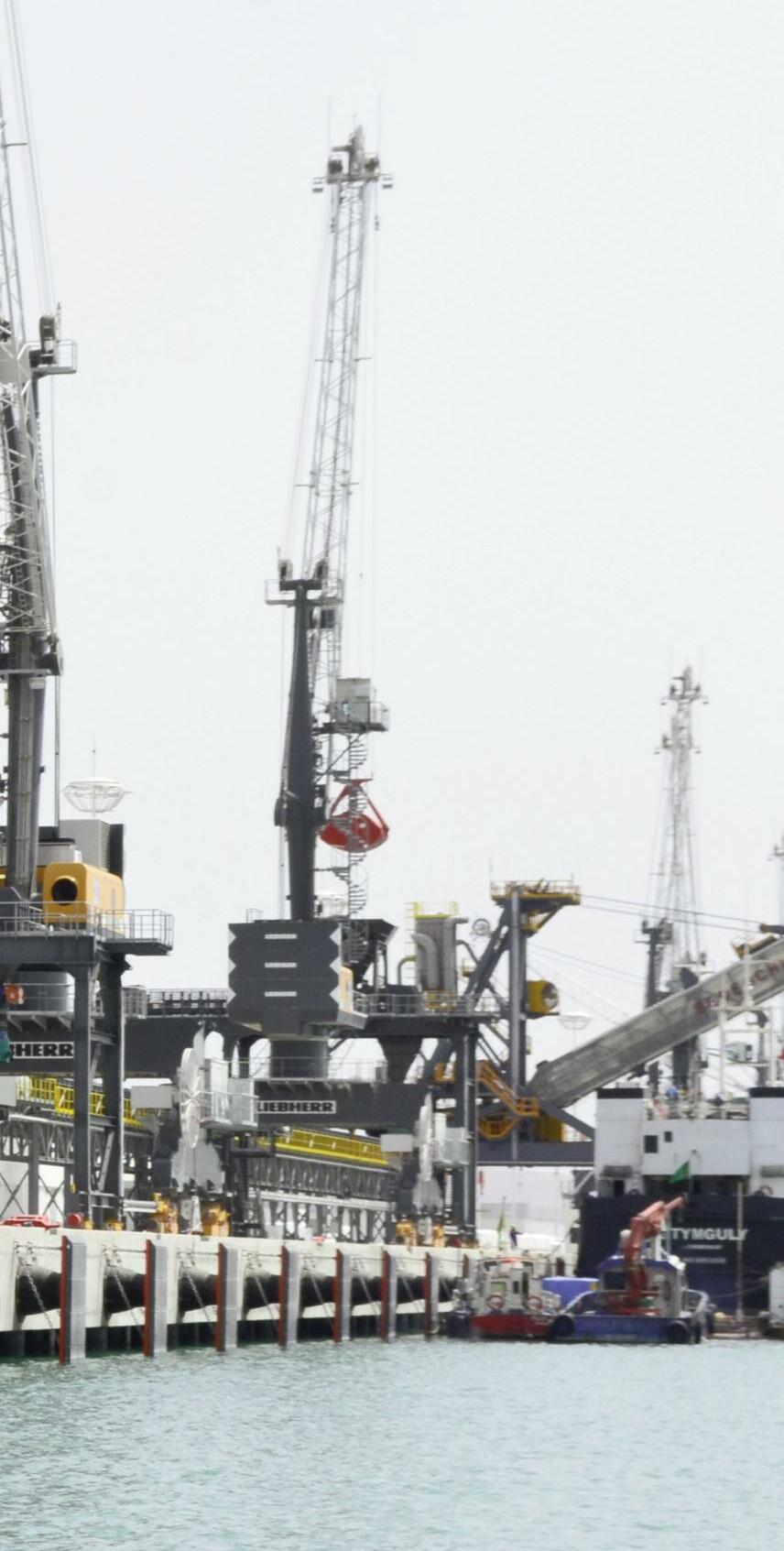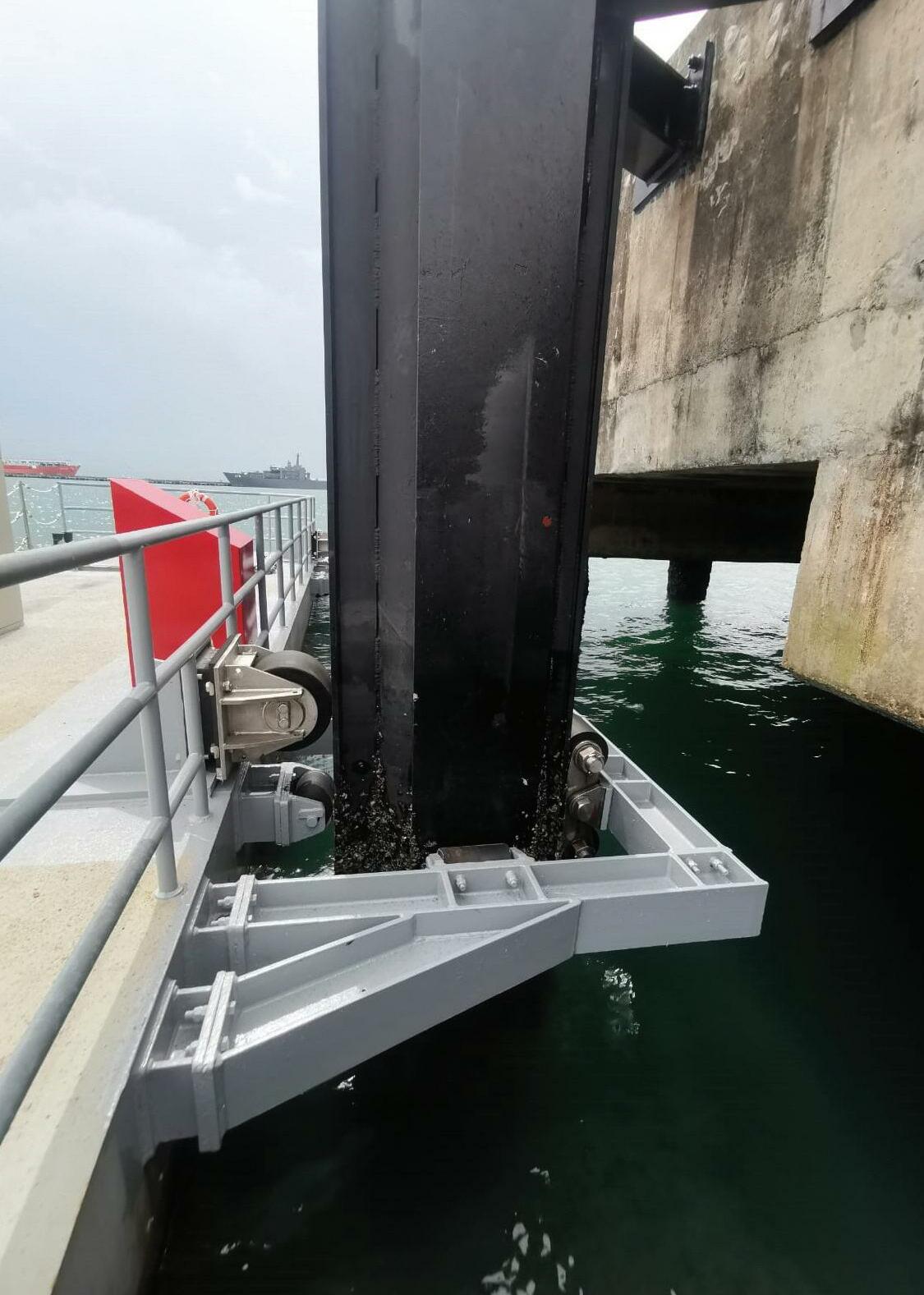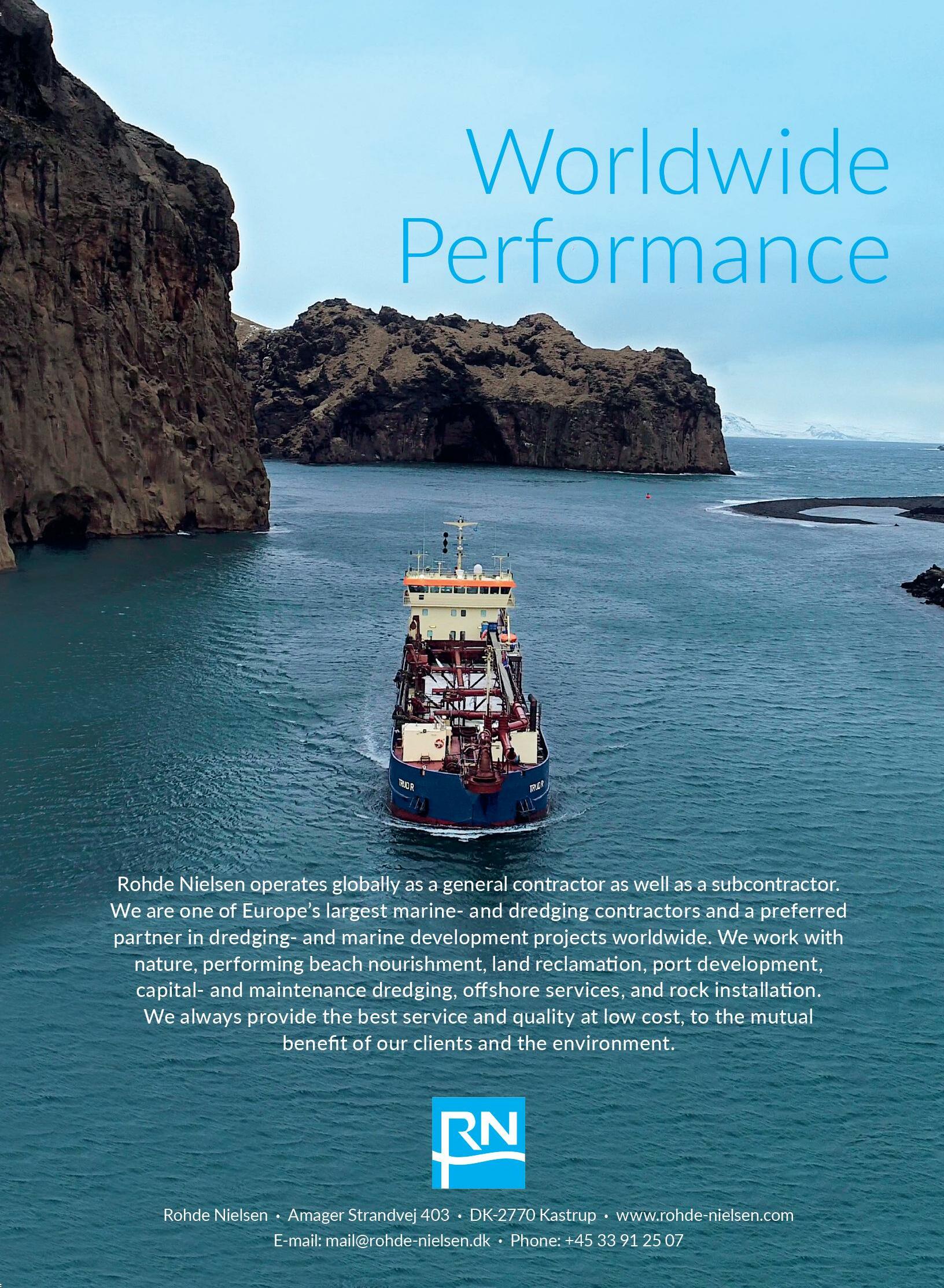
9 minute read
Customisation the (new) standard
What it looks like:A Trajectory to Customisation
Projects that speak for themselves The construction of a completely new port is a huge project, coming with the same project conditions, such as weather, tides and water levels, but challenged to meet many different requirements.This is the case of the international Seaport of Turkmenbashi, the largest on the Caspian Sea, customised to safely berth different types of vessels at its different terminals: general cargo, dry bulk, ferry, shipyard, passengers and containers.
On the other hand, there is a single pontoon in Singapore in an exposed location with strong currents, swell and choppy waters that needs to perform 24/7. Customisation came with extra support of the Cushion Roller to dampen the main impacts and with the addition of a roller hinge to accommodate the tilting movements.
The small passenger terminal in Stubbekoebing (Denmark) needed a curved fender system so the ferries could pivot ” around” the dolphin, which serves as a turning support. The customer ’ s requirements in this case called for customisation in the engineering, solved with a pre-bent panel that snugly fits around the dolphin, creating an energy absorbing and deflecting fender system. A recent project in Norway came with the challenge of differently sized dolphins to which the fenders had to be installed.Additionally, the existing concrete was quite old and partly damaged, and the required stand-off distance was rather small, posing a high demand for the design and installation of fenders, panels and chains.These three challenges were overcome with a customised product that integrated special tubes into the steel panels to avoid the need of additional flanges.
Logistics can also be the focus of attention, especially if the construction site is located near the centre of a large city, where the lack of space to store materials is one of the biggest issues. In this case in Sweden, customisation comes in the shape of the delivery being done in separate shipments, simple solution but not handy for every supplier.
And what about if the construction happens in Antarctica, an “ ecologically fragile and worth preserving ” environment.In such environments, the short installation window (only possible during the Antarctic summer) required a customised service and a very close and individual coordination between the client, the contractor and the manufacturer: “Try to imagine all the steps they [the installation crew] have to take and under what conditions they have to do it. If you give them small bits and pieces to assemble in -50°C. Give the team something that’ s easy to assemble and to perform for a long time without maintenance. ”
To finish this trajectory, let’ s look ahead in the future where customisation is coming in the form of sustainability.A LNG project in Jakarta (Indonesia): “After 10 year of being exposed 24/7 to waves, wind, sun, and salt water at an offshore terminal without major maintenance, all fenders are still in good condition ” and will continue to do so for at least the next 10 years.
With more than six decades of group experience, ShibataFenderTeam have always had the focus on customisation. For the past five years, we have advocated in the industry for a holistic approach to fender system design, valuing the aspects of project conditions,system components and manufacturing as being seen equally. Starting in 2021, we finally noticed an evolution within the industry and corresponding standards, and it is good to see that others finally follow.
What to expect from 2023
Sustainability will move further to the centre of the table with the goal to reduce emissions. Reducing the impact is key, like with reskinning Foam Fenders so they can be used again and do not need to be manufactured new - which we have done for the Port of Kiel (Germany). Also reduce from the beginning, which means

The international Seaport of Turkmenbashi, the largest on the Caspian Sea, customised to safely berth different types of vessels at its different terminals.

working with a sustainable and green design to extend the life cycle of fenders. Following this approach, it will not be necessary to waste more raw material and other resources for early refurbishments or even new fenders in cases of damages.
The industry path in 2023 will also be influenced by the release of the updated ‘Guideline for the design of fender systems ’ ,revised by PIANC Working Group 211. Being future oriented, this updated guideline will strengthen a sustainable approach and includes a holistic view to fender system design. For the market, we expect a further positive development. First with the - hopefully soon to be calmed down and solved - disruption of the supply chain (with regards to raw materials and shipment in general) and also with Governments maintaining the flow of money for infrastructure projects to work against the Corona impacts.
Finally, we have seen two applications rising lately as key in the industry. Energy diversification being the uppermost concern, has meant that LNG supply installations are a big topic in Northern Europe: new terminals are being built to help countries to become more energy independent.And, back to normal after the Corona crisis, cruise projects which had been paused due to the pandemic are flourishing as tourism starts up again.
Herein: On a project in Singapore in an exposed location with strong currents, swell and choppy waters, customisation came with the extra support of the Cushion Roller. Below: Reskinning Foam Fenders so they can be used again and do not need to be manufactured new successfully done for the Port of Kiel.


igusrecentlypresenteditsrevolutionary mobileshorepowertechnology,the readychain®iMSPO,atthePorts‘22 conferenceinHawaiiinSeptember. WPDreports...

gus, based in Germany, runs its North
American operations out of Providence,
Rhode Island.The readychain® iMSPO, which is going to be installed in European ports as a self-propelled socket for the shore power connection of container strips, is now available in the United States.
Ports are critical to jobs, competitiveness and economic prosperity for the United States. When in port, vessels such as cruise ships, container ships,and reefer ships have significant energy needs.Today, this energy is typically generated by ships ’ auxiliary diesel engines. Emissions from ships at berth contribute significantly to air pollution and cause health problems for local residents. Based on its core competence in the field of energy supply systems with energy chains, igus has developed a movable socket that travels along the quay over hundreds of meters precisely to the respective connection position of the ship.
Reducing emissions
Like all industries, ports are facing the major challenge of reducing pollutant emissions and ultimately becoming climate-neutral.When ships at berth obtain their electricity with diesel generators, the demand is immense, similar to that of a small town.The generators also emit CO2, as well fine dust and nitrogen and sulfur oxides. Shore power can be used by ships to connect to the local power grid. Auxiliary engines can then be switched off while in port. This allows power for lighting or air conditioning or other electronic equipment on board for the crew to draw from the local power grid. Shore power thus serves to reduce emissions from auxiliary engines at berth. The advantage of shore power technology is that there is an internationally recognised standard and pilot systems that are already operating successfully. However, as with any new infrastructure, there are great challenges to be faced, whereby encouragement is needed and someone to lead the way.
igusigus bringsbrings shoreshore powerpower toto U.S.U.S. porportsts
Port of Hamburg takes first step
California was the first in the world to implement shore power. Now, five major European ports - Hamburg,Bremerhaven,Rotterdam,Antwerp and Le Havre - have jointly agreed to supply their container ships of 14,000TEUs or more with shoreside electricity by 2028.In the U.S., the ports of San Diego and Miami are investing millions of dollars in the new shore power technology, also known as cold ironing.
The Port of Hamburg has decided to take the first step and install the world’ s first mobile connection systems for container ships. In addition to the technical challenges of power supply, such as the right voltage and frequency, another problem must be solved for the future-proof operation of a shore power system - the connection dilemma.
A container terminal is a carefully timed operation with constantly changing ships of different sizes and berthing positions. This means that the connection points vary continually - there is no fixed place where the vessel can be “ plugged in. ” The Port of Hamburg therefore relies on the movable connection systems from igus.
Flexible systems solve the connection dilemma
Every port is unique: tidal behavior, terminal design and equipment differ from port to port. Container ships equipped for shore power carry a cable reel on board that makes it possible to lower two cables with connectors down onto the quay.These can then be connected to appropriate couplings on the quay.
However, the cable reel may be installed at different positions on the ship. Ships can dock at the quay at either the port or starboard side.Vessels also vary considerably in size.This means that no fixed connection point will be right for all situations.
The iMSPO (igus Mobile Shore Power Outlet) system is a solution to this connection problem: The combination of igus roller energy chain and special chainflex® medium-voltage cables enables the system to travel within a range of up to 400 meters (which corresponds to the length of the largest container ships).
Due to the small bending radii of the chainflex® cables, the system can be designed compactly and mounted in a space-saving manner.Thus, shore power availability is provided over the entire berth. The movable socket is moved along the quay, exactly to the point where the ship ’ s connection point is located.The ship cables only have to be lowered and connected to the movable socket.The iMSPO is operated with a remote control.
The knowledge gained through interaction with customers and the company ’ s own experience from successfully installed shore power systems for ferries, FSUs (floating storage units), OSVs (offshore supply vessels) and the largest working vessels in Rotterdam were incorporated into the development.
The possibility of testing the system ’ s functionality in igus ’ test laboratory, which is the largest in the industry, was a decisive factor in the decision.
“Being able to be a part of this project is a great honor for us, ” said Martin Tiling, Shore Power industry manager at igus.
“We are proud to be part of a new green innovation and are confident that our ideas and technologies will continue to contribute to a more climate-friendly future. ”






